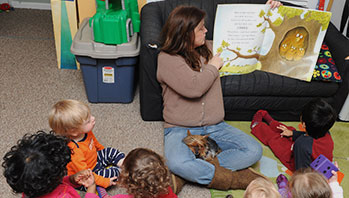- nonfiction books about bears (optional)
- hibernation
- snore
- sound
MA Standards:
Literature/RL.PK.MA.1: With prompting and support, ask and answer questions about a story or a poem read aloud.
Literature/RL.PK.MA.6: With prompting and support, “read” the illustrations in a picture book by describing a character or place depicted, or by telling how a sequence of events unfolds.
Literature/RL.PK.MA.9: With prompting and support, make connections between a story or poem and one’s own experiences.
Head Start Outcomes:
Language Development/Receptive Language: Attends to language during conversations, songs, stories, or other learning experiences.
Literacy Knowledge/Book Appreciation and Knowledge: Asks and answers questions and makes comments about print materials.
Logic and Reasoning/Symbolic Representation: Recognizes the difference between pretend or fantasy situations and reality.
PreK Learning Guidelines:
English Language Arts/Reading and Literature 6: Listen to a wide variety of age appropriate literature read aloud.
English Language Arts/Reading and Literature 12: Listen to, recite, sing, and dramatize a variety of age-appropriate literature.
English Language Arts/Reading and Literature 10: Engage actively in read-aloud activities by asking questions, offering ideas, predicting or retelling important parts of a story or informational book.
Bear Snores On #1

© Commonwealth of Massachusetts, Department of Early Education and Care (Jennifer Waddell photographer). All rights reserved.
STEM Key Concepts: Sounds have a source; Different objects make different sounds; Sounds vary in three ways: volume, pitch, and timbre
ELA Focus Skills: Concepts of Print, Making Connections, Speaking and Listening, Story Comprehension, Vocabulary
Before You Read
Introduce the book Bear Snores On by Karma Wilson.
Hold up the book so children can see the front and back covers at the same time. Point to the words as you read aloud the title and the names of the author and illustrator.
- Ask children to describe what animals they see on the cover. Help children identify the different animals. Ask, Have you ever seen a bear or read a story about a bear? Encourage children to share what they know about bears.
- Point to the bear and say, The bear in this picture is asleep. Tell children that it’s hard for bears to live outside during the cold winter, so they go into a very deep sleep called hibernation. Explain that bears wake up in the spring when the weather is warm and come out of their caves.
- Tell children that the sleeping bear in this story snores. Ask, Have you ever heard someone snore? What does that sound like? Do all snores sound the same? Set a reading focus for children by asking children to listen carefully for the different sound words in the story as you read.
As You Read
Read with expression, emphasizing the sounds in the story.
- As you say the sound words, reflect them in your voice. For example, use a low, deep voice for a growl. Invite children to make the sounds with you.
- Use facial gestures and motions to demonstrate the meaning of words and phrases such as shut tight, pitter-pat, tip-toe, and creep-crawls.
After You Read
Review with children the different sounds the animals make.
- Hold up the spread that shows the bear waking up. Point to the illustration of the bear. Ask, How do you think the bear is feeling? How do you know? Act out the sound words that help children see the bear is angry.
- Point to the other animals and ask, What sounds do you think these animals make as they run away from the bear? Do you think they are making the same sounds as the bear?
- Turn to the next spread where the bear hides his face in his paws. Point to the bear. Ask, Do you think the bear is still angry? Act out the sound words with children.
Take It Further: Have nonfiction books about bears readily available. Have children choose one and then read it aloud. Talk with children about what they notice is different about the bears in the two books. Explain that one book is fiction and the other is nonfiction, and that in the fiction book, Bear Snores On, the bear can do things that real bears cannot. Say, Which book would I read if I wanted to know real facts about bears? Which book would I read if I wanted to enjoy a make-believe story about bears?
